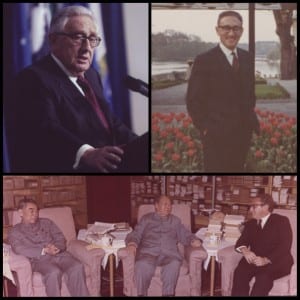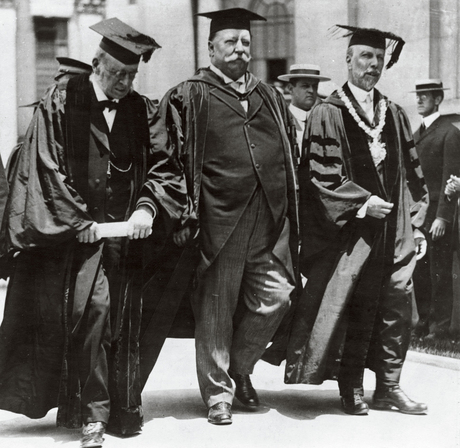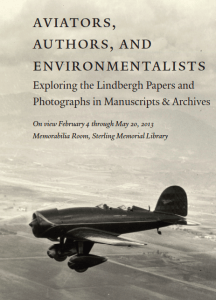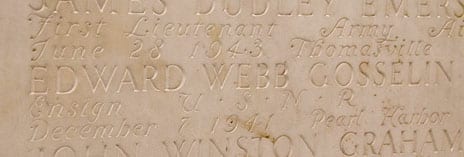 Manuscripts and Archives is pleased to announce the availability of the papers of Henry A. Kissinger, former Secretary of State (1973-1977) and Assistant to the President for National Security Affairs (1969-1975). The papers document Dr. Kissinger’s pre-government, government, and post-government careers and are comprised of correspondence, memoranda, writings, speeches, photographs, films, videos, sound recordings, and other material. The papers have been digitized and the collection overview page provides information on collection content, research strengths, access to the digital collection, and ownership and copyright. Please consult: http://web.library.yale.edu/digital-collections/kissinger-collection
Manuscripts and Archives is pleased to announce the availability of the papers of Henry A. Kissinger, former Secretary of State (1973-1977) and Assistant to the President for National Security Affairs (1969-1975). The papers document Dr. Kissinger’s pre-government, government, and post-government careers and are comprised of correspondence, memoranda, writings, speeches, photographs, films, videos, sound recordings, and other material. The papers have been digitized and the collection overview page provides information on collection content, research strengths, access to the digital collection, and ownership and copyright. Please consult: http://web.library.yale.edu/digital-collections/kissinger-collection
Author Archives: klg22
William Howard Taft
See the interesting blog post attached below, recently from the Yale Alumni Magazine’s “This Just In” blog. The post discusses former president Taft’s consideration, and reasons for not wanting to accept, the position of president of Yale University. There are a number of different historical resources related to this article at Manuscripts and Archives, including the class books the Class of 1878, Skull and Bones membership lists that include Taft, as well as photos and records from commencement and other events attended by Taft.
When Taft turned Yale down
 President Taft, then a Yale trustee, at Commencement in 1911 with former Yale president Timothy Dwight (left) and then Yale president Arthur Twining Hadley. Photo: Manuscripts and Archives.
President Taft, then a Yale trustee, at Commencement in 1911 with former Yale president Timothy Dwight (left) and then Yale president Arthur Twining Hadley. Photo: Manuscripts and Archives.
At about this time 100 years ago, William Howard Taft (Yale Class of 1878) had just left the White House and was taking a short vacation before starting a new job: professor of constitutional law at Yale. But as I learned while writing a short piece for our new issue about the chairs Taft sat in during his professorship, Taft had earlier been considered for another job at Yale. And his reason for not taking it tells you how much times have changed.
When Yale president Timothy Dwight left office in 1899, Taft’s friends urged the Yale Corporation to consider him for the job. At age 42, Taft was then a federal judge and former US solicitor general; he was also serving as dean of the University of Cincinnati law school. A sympathetic Taft biographer says that he modestly declined because he did not feel he had enough experience in higher education. But Taft had a more interesting reason not to pursue the job: in 1899, Yale was still moored, if loosely, to its Congregationalist roots, and every president to that date had been an ordained minister. Taft saw this as a problem, as he wrote in a letter to his brother Henry:
It would shock the large conservative element of those who give Yale her power and influence in the country to see one chosen to the Presidency who could not subscribe to the creed of the orthodox Congregational Church of New England . . . I am a Unitarian. I believe in God. I do not believe in the Divinity of Christ, and there are many other of the postulates of the orthodox creed to which I cannot subscribe. I am not, however, a scoffer at religion but on the contrary recognize, in the fullest manner, the elevating influence that it has had and always will have in the history of mankind.”
Taft’s religious beliefs were not a major issue, though, when he ran for president of the United States in 1908. Today, Yale’s second Jewish president is preparing to take office. But how would a candidate who didn’t “believe in the Divinity of Christ” fare in a race for president of the US today?
Essay on Slavery
 “Essay on Slavery,” a manuscript poem in the Hillhouse Family Papers in Manuscripts and Archives, Yale University Library, written in 1786 by Jupiter Hammon, a slave, has received scholarly recognition by Professor Cedrick May of the University of Texas, Arlington. Presented by the Americanist Colloquium and the African-American Studies Department at Yale on February 21, Professor May discussed his literary and biographical findings on Hammon, the first African American to publish literary works in America. Hammon identified himself in the manuscript as “A Negro Man belonging to Mr. John Lloyd, Queens Village on Long Island. November 10, 1786.” Sarah Lloyd, John Lloyd’s daughter, was the first wife of James Hillhouse (1754-1832), an early abolitionist and developer of New Haven and Yale, who as a U.S. senator worked to abolish the slave trade in 1807 and to prohibit slavery in the Louisiana Territory. Professor May is working on a new edition of Hammon’s poetry and prose. The research by May and his student Julie McCown at Yale is the focus of an article to be published in the June 2013 edition of the journal Early American Literature along with the full text of Hammon’s “An Essay on Slavery.”
“Essay on Slavery,” a manuscript poem in the Hillhouse Family Papers in Manuscripts and Archives, Yale University Library, written in 1786 by Jupiter Hammon, a slave, has received scholarly recognition by Professor Cedrick May of the University of Texas, Arlington. Presented by the Americanist Colloquium and the African-American Studies Department at Yale on February 21, Professor May discussed his literary and biographical findings on Hammon, the first African American to publish literary works in America. Hammon identified himself in the manuscript as “A Negro Man belonging to Mr. John Lloyd, Queens Village on Long Island. November 10, 1786.” Sarah Lloyd, John Lloyd’s daughter, was the first wife of James Hillhouse (1754-1832), an early abolitionist and developer of New Haven and Yale, who as a U.S. senator worked to abolish the slave trade in 1807 and to prohibit slavery in the Louisiana Territory. Professor May is working on a new edition of Hammon’s poetry and prose. The research by May and his student Julie McCown at Yale is the focus of an article to be published in the June 2013 edition of the journal Early American Literature along with the full text of Hammon’s “An Essay on Slavery.”
- For more information, see the online finding aid to the Hillhouse Family Papers at: http://hdl.handle.net/10079/fa/mssa.ms.0282.
- To place a request for access in the reading room to the specific box (Box 80A) that this poem is contained within, click here.
- The four page poem has been digitized and can been seen online in the Manuscripts and Archives Digital Image Database, click here. It is possible to order high-quality photoduplication of these images, using the information regarding ordering found on that site.
Lindbergh Exhibit Opens
 The manuscript materials and photographs in Manuscripts & Archives documenting Charles A. and Anne Morrow Lindbergh and their families comprise rich resources for the study of a wide array of topics relating to the United States and the rest of the world during the decades from the 1920s to the 1970s. This exhibit celebrates the formal opening to research of the Lindbergh collections. From pioneering contributions to aviation and commercial passenger airline service, to activities that contributed to the success of the United States’ efforts during World War II, to far-sighted engagement with and support of early wildlife and land conservation efforts worldwide, to careers as celebrated and widely read authors, the exhibit explores the importance of the Lindberghs’ endeavors and highlights the expected and unanticipated gems that research in archival collections can uncover. The exhibit is on display from February 4—April 20, 2013, in the Sterling Memorial Library Memorabilia Room.
The manuscript materials and photographs in Manuscripts & Archives documenting Charles A. and Anne Morrow Lindbergh and their families comprise rich resources for the study of a wide array of topics relating to the United States and the rest of the world during the decades from the 1920s to the 1970s. This exhibit celebrates the formal opening to research of the Lindbergh collections. From pioneering contributions to aviation and commercial passenger airline service, to activities that contributed to the success of the United States’ efforts during World War II, to far-sighted engagement with and support of early wildlife and land conservation efforts worldwide, to careers as celebrated and widely read authors, the exhibit explores the importance of the Lindberghs’ endeavors and highlights the expected and unanticipated gems that research in archival collections can uncover. The exhibit is on display from February 4—April 20, 2013, in the Sterling Memorial Library Memorabilia Room.
Living History
YaleNews | Remembering alumnus’ sacrifice at Pearl Harbor
To mark Pearl Harbor Day, YaleNews published a story by Chief Research Archivist, Judith Schiff describing Edward Webb Gosselin’s sacrifice at Pearl Harbor. See: YaleNews | Remembering alumnus’ sacrifice at Pearl Harbor.
Discussing New Haven History
Chief Research Archivist Judith Schiff took part in a discussion on the history of New Haven and the New Haven Register on the WNPR radio talk show Where We Live. Click on the link that follows to listen to the broadcast (Judith enters the discussion 6:25 into the show).
Where We LIve (December 6, 2012)
Manuscripts and Archives offers dozens of collections pertinent to New Haven history. Among the more heavily used are:
- Oral Histories Documenting New Haven, Connecticut: http://hdl.handle.net/10079/fa/mssa.ru.1055. The materials consist of audio recordings and transcripts of oral histories conducted by New Haven Oral History Project staff with New Haven, Connecticut, citizens.
- Buildings, Grounds and Landmarks in New Haven Photographs: http://hdl.handle.net/10079/fa/mssa.ru.0685. The materials consist of maps, photographs, engravings, drawings, slides, and lithographs of New Haven, Connecticut scenes, residences, buildings, and landmarks. The bulk of The materials consist of photographs of New Haven and surrounding environs from 1860-1930s. Included are aerial views, scenes of the New Haven Green, photographs of streets, and various individual residences. Of particular interest are the snapshots of houses used for tax purposes, or as documentation of the structure before demolition.
- Yale Student papers Collection: http://hdl.handle.net/10079/fa/mssa.ru.0331. The collection consists of research papers and essays by Yale students. Included are many prize-winning essays on New Haven and Yale history.
- Richard C. Lee Papers: http://hdl.handle.net/10079/fa/mssa.ms.0318. The papers contain correspondence, memoranda, position papers, reports, speeches, appointment books, photographs, scrapbooks, and films documenting the career of Richard C. Lee, mayor of New Haven, 1954-1969. The Lee Papers document the professional and public life of Lee, not his personal life. The papers contain correspondence and other materials on the practice of urban politics, urban renewal, New Haven’s efforts in the war on poverty, civil rights and race relations, town-gown relations, and his interaction with local and state Democratic Party leaders. The papers also include campaign files covering the period 1949-1968, appointment books, photographs documenting the course of redevelopment, a small amount of material on Lee’s life after he left office, and political scrapbooks.
- New Haven Redevelopment Agency Records: http://hdl.handle.net/10079/fa/mssa.ms.1814. Project files, minutes, correspondence, and property records, documenting the work of the New Haven Redevelopment Agency, primarily from the 1950s to the 1980s.
Another valuable resource for New Haven History is the New Haven Museum, located at 114 Whitney Avenue. Collections related to the founding of the New Haven colony to its present are accessible at the Museum’s Whitney Library. To plan a research visit, please see http://www.newhavenmuseum.org/index.php?option=com_content&view=article&id=38&Itemid=103.
Yale University Presidents
Recently, Provost Peter Salovey was announced as the University’s next president, succeeding Richard C. Levin, effective June 30, 2013. For more information, follow the links below:
- Announcement to the Yale Community from Edward P. Bass ’67, Senior Fellow of the Yale Corporation
- YaleNews: Yale provost Peter Salovey to be the University’s next president
- New York Times: Yale Names Insider, Peter Salovey, Its New President
- Provost and President-Elect Salovey’s full biography can be read on Yale’s University leadership page.
Yale Presidents Throughout History
Watch this recent video interview of Judith Schiff, Chief Research Archivist in Manuscripts and Archives, discussing Yale University Presidents through the years:
Researching Yale Presidents in Manuscripts and Archives
Manuscripts and Archives holds a wealth of historical information and documentation of Yale presidents through the years. Examples of the types of materials that can be found include:
- Finding Aids for Records of the Office of the President, Yale University
- A historical listing of Rectors and Presidents of Yale University
- The Yale Daily News online archive (containing many articles and notices about Yale presidents)
- The Manuscripts and Archives Digital Image Database (contains may images of Yale presidents and their records)
- Books in the Yale University Library can be found under the local call number of Yb13. Check Orbis for examples. Online versions of some of these items can be found in the HathiTrust Digital Library






